Abstract
Patients with methylmalonic aciduria have an excessive intramitochondrial accumulation of acylcoenzyme A compounds that may reduce the availability of free coenzyme A (CoA) for normal metabolic requirements, producing profound metabolic disturbances. Giving carnitine to a patient with methylmalonic aciduria produced an increase in hippurate excretion (an index of intramitochondrial adenosine triphosphate (ATP) and CoA availability), a large increase in short chain urinary acylcarnitines, and a reduction in excretion of methylmalonate and methylcitrate. These acylcarnitines were shown by fast atom bombardment and B/E linked scan mass spectrometry to be propionylcarnitine and acetylcarnitine. Carnitine acts by removing (detoxifying) propionyl groups, thereby releasing CoA and restoring ATP biosynthesis and concentrations towards normal. L-carnitine may play a central role in maintenance of mitochondrial and cellular homoeostasis in methylmalonic aciduria and propionic acidaemia. These principles may provide an approach to the treatment of this and other disorders, inherited and acquired, in which accumulation of acyl CoA metabolites results in sequestration of free CoA, thereby perturbing metabolic homoeostasis.
Full text
PDF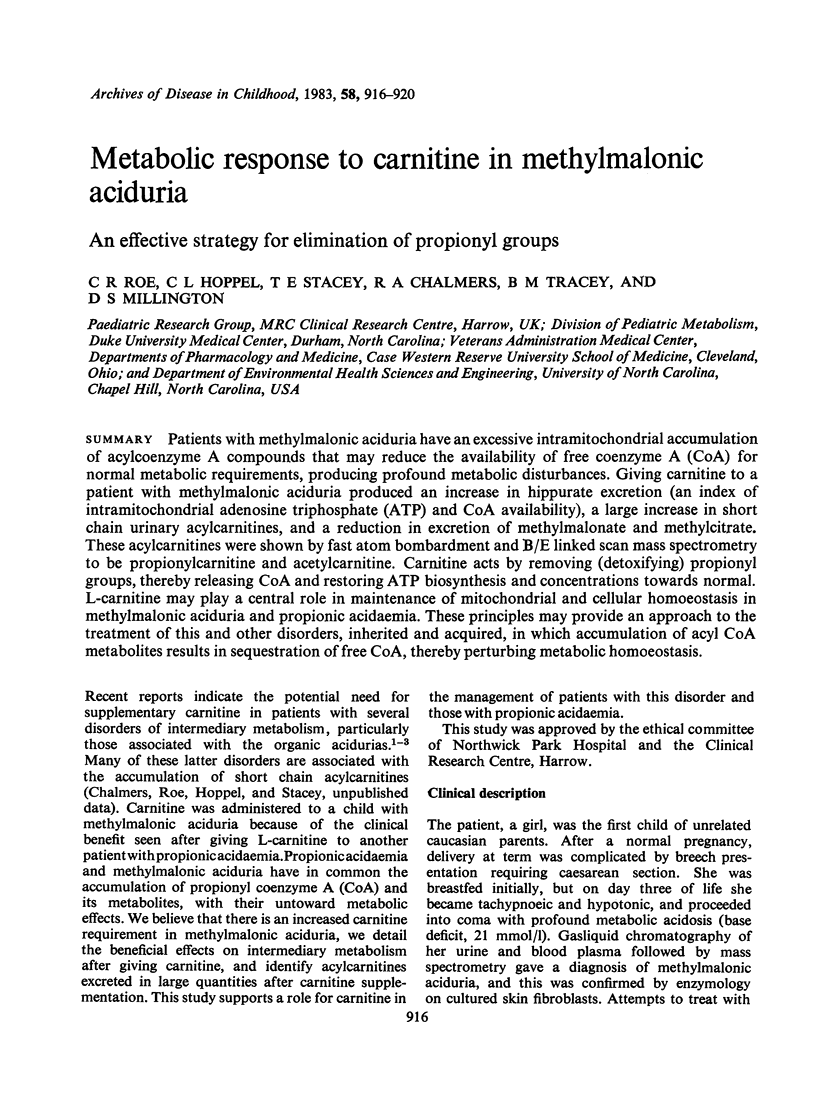
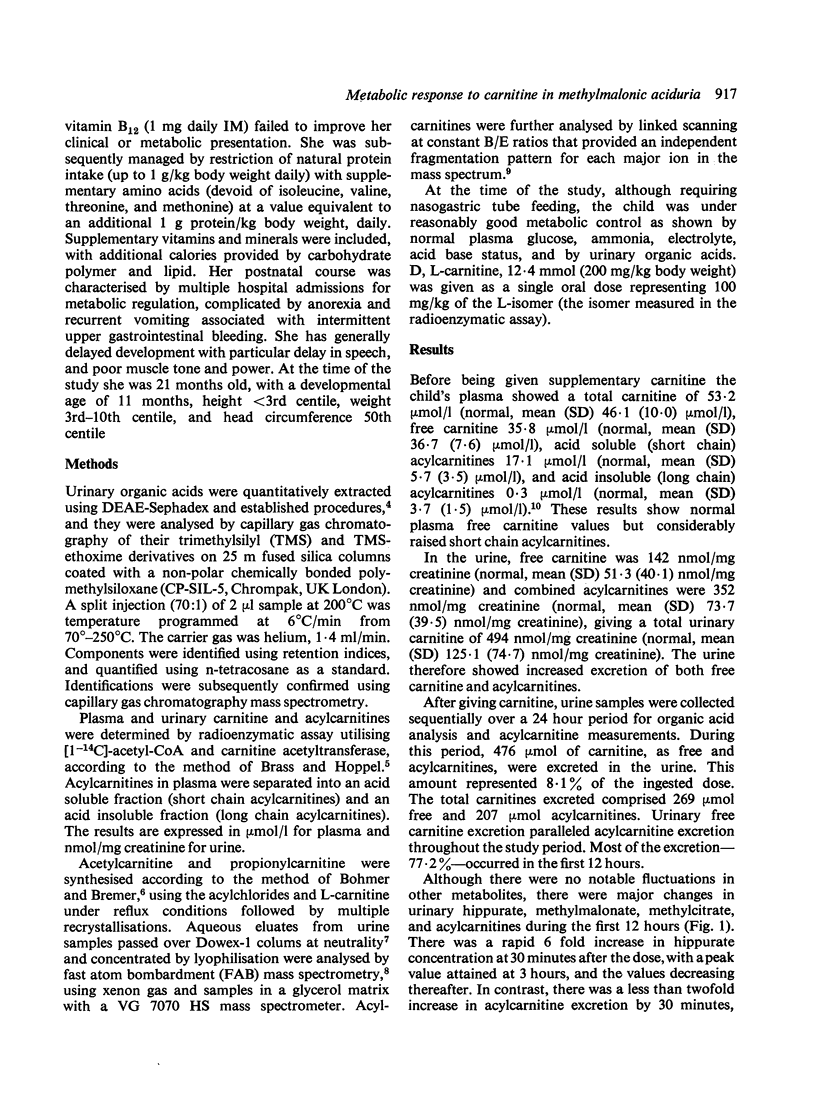
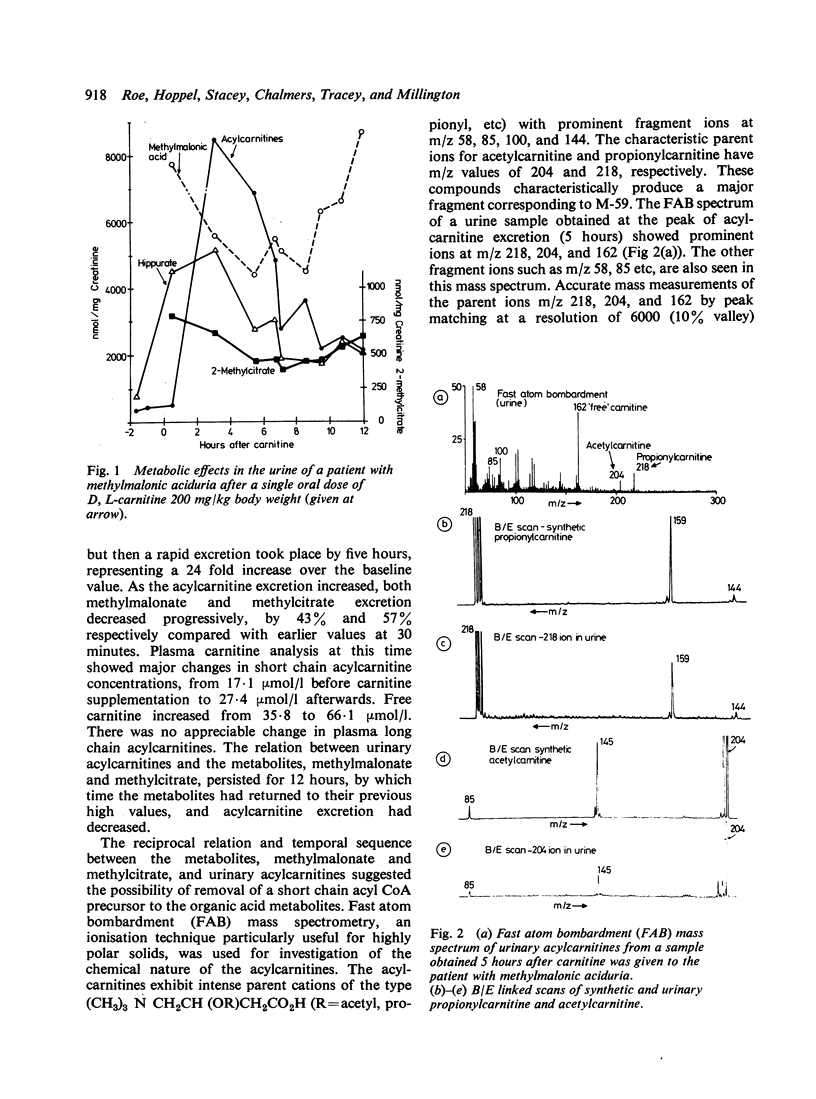
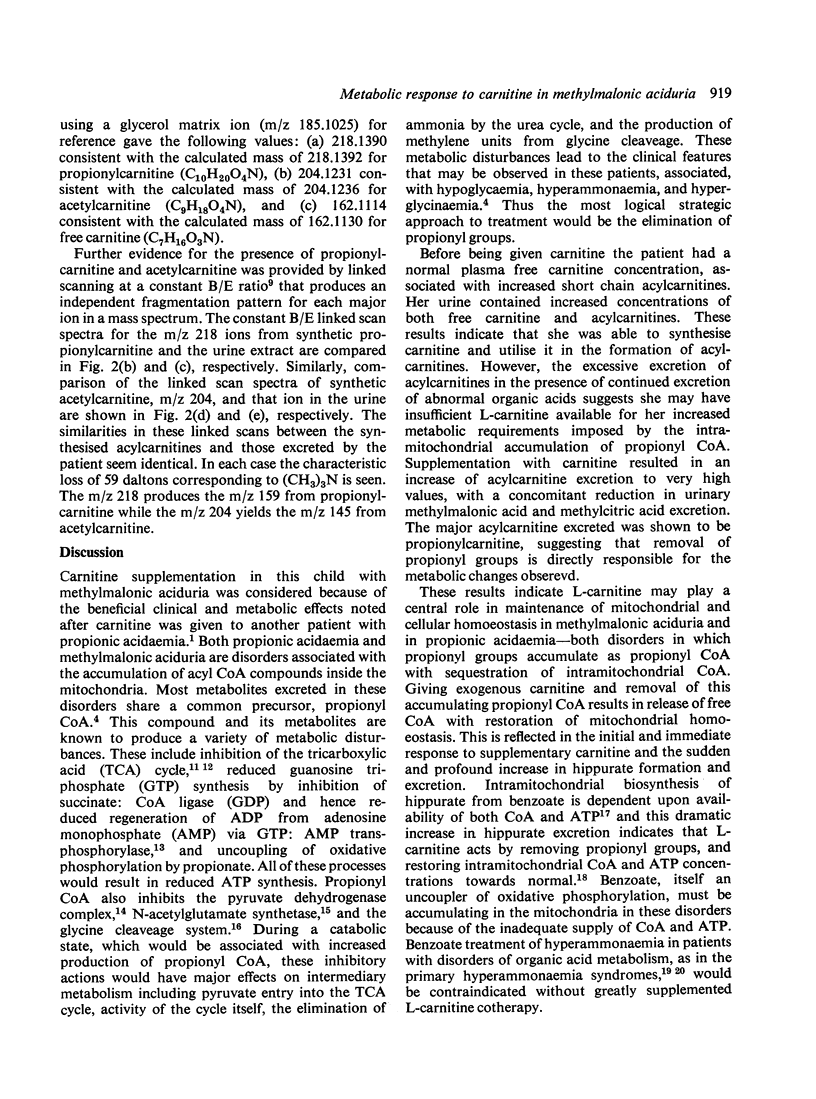
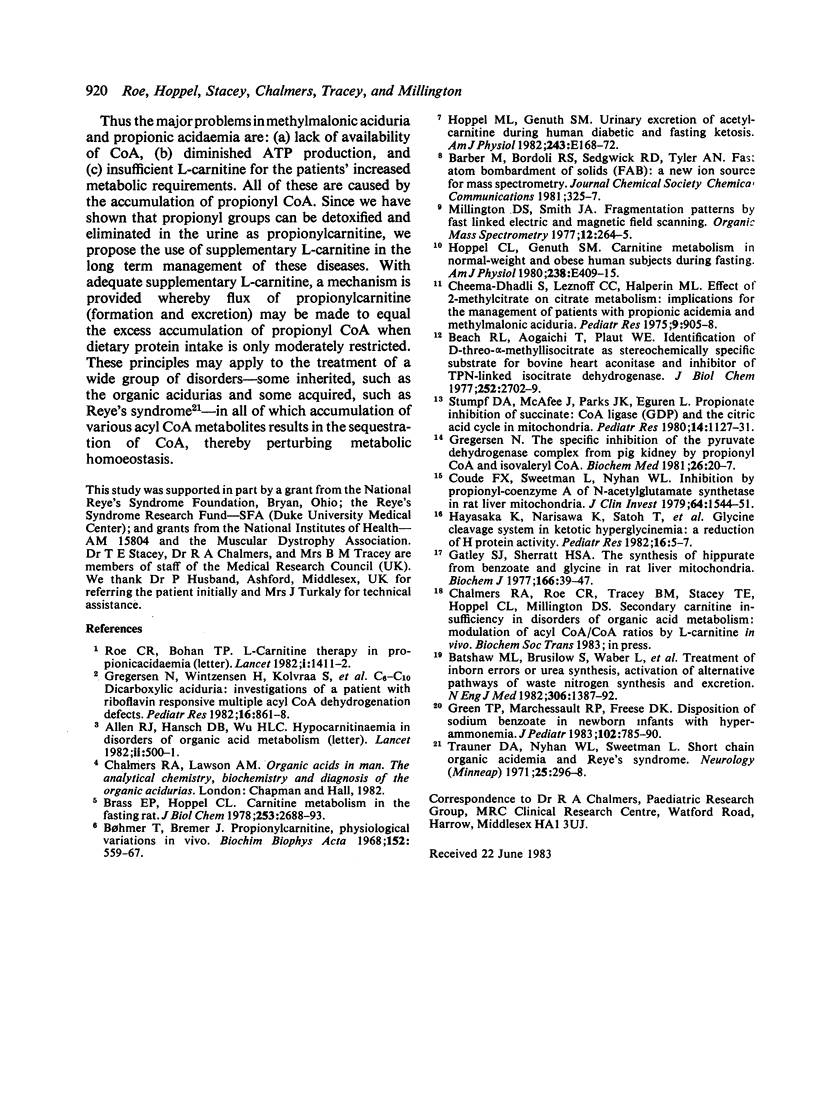
Selected References
These references are in PubMed. This may not be the complete list of references from this article.
- Allen R. J., Hansch D. B., Wu H. L. Hypocarnitinemia in disorders of organic acid metabolism. Lancet. 1982 Aug 28;2(8296):500–501. doi: 10.1016/s0140-6736(82)90532-3. [DOI] [PubMed] [Google Scholar]
- Batshaw M. L., Brusilow S., Waber L., Blom W., Brubakk A. M., Burton B. K., Cann H. M., Kerr D., Mamunes P., Matalon R. Treatment of inborn errors of urea synthesis: activation of alternative pathways of waste nitrogen synthesis and excretion. N Engl J Med. 1982 Jun 10;306(23):1387–1392. doi: 10.1056/NEJM198206103062303. [DOI] [PubMed] [Google Scholar]
- Beach R. L., Aogaichi T., Plaut G. W. Identification of D-threo-alpha-methylisocitrate as stereochemically specific substrate for bovine heart aconitase and inhibitor of TPN-linked isocitrate dehydrogenase. J Biol Chem. 1977 Apr 25;252(8):2702–2709. [PubMed] [Google Scholar]
- Bohmer T., Bremer J. Propionylcarnitine. Physiological variations in vivo. Biochim Biophys Acta. 1968 May 1;152(3):559–567. doi: 10.1016/0005-2760(68)90096-9. [DOI] [PubMed] [Google Scholar]
- Brass E. P., Hoppel C. L. Carnitine metabolism in the fasting rat. J Biol Chem. 1978 Apr 25;253(8):2688–2693. [PubMed] [Google Scholar]
- Cheema-Dhadli S., Leznoff C. C., Halperin M. L. Effect of 2-methylcitrate on citrate metabolism: implications for the management of patients with propionic acidemia and methylmalonic aciduria. Pediatr Res. 1975 Dec;9(12):905–908. doi: 10.1203/00006450-197512000-00008. [DOI] [PubMed] [Google Scholar]
- Coude F. X., Sweetman L., Nyhan W. L. Inhibition by propionyl-coenzyme A of N-acetylglutamate synthetase in rat liver mitochondria. A possible explanation for hyperammonemia in propionic and methylmalonic acidemia. J Clin Invest. 1979 Dec;64(6):1544–1551. doi: 10.1172/JCI109614. [DOI] [PMC free article] [PubMed] [Google Scholar]
- Gatley S. J., Sherratt H. S. The synthesis of hippurate from benzoate and glycine by rat liver mitochondria. Submitochondrial localization and kinetics. Biochem J. 1977 Jul 15;166(1):39–47. doi: 10.1042/bj1660039. [DOI] [PMC free article] [PubMed] [Google Scholar]
- Green T. P., Marchessault R. P., Freese D. K. Disposition of sodium benzoate in newborn infants with hyperammonemia. J Pediatr. 1983 May;102(5):785–790. doi: 10.1016/s0022-3476(83)80259-5. [DOI] [PubMed] [Google Scholar]
- Gregersen N. The specific inhibition of the pyruvate dehydrogenase complex from pig kidney by propionyl-CoA and isovaleryl-Co-A. Biochem Med. 1981 Aug;26(1):20–27. doi: 10.1016/0006-2944(81)90026-0. [DOI] [PubMed] [Google Scholar]
- Gregersen N., Wintzensen H., Christensen S. K., Christensen M. F., Brandt N. J., Rasmussen K. C6-C10-dicarboxylic aciduria: investigations of a patient with riboflavin responsive multiple acyl-CoA dehydrogenation defects. Pediatr Res. 1982 Oct;16(10):861–868. doi: 10.1203/00006450-198210000-00012. [DOI] [PubMed] [Google Scholar]
- Hayasaka K., Narisawa K., Satoh T., Tateda H., Metoki K., Tada K., Hiraga K., Aoki T., Kawakami T., Akamatsu H. Glycine cleavage system in ketotic hyperglycinemia: a reduction of H-protein activity. Pediatr Res. 1982 Jan;16(1):5–7. doi: 10.1203/00006450-198201001-00002. [DOI] [PubMed] [Google Scholar]
- Hoppel C. L., Genuth S. M. Carnitine metabolism in normal-weight and obese human subjects during fasting. Am J Physiol. 1980 May;238(5):E409–E415. doi: 10.1152/ajpendo.1980.238.5.E409. [DOI] [PubMed] [Google Scholar]
- Hoppel C. L., Genuth S. M. Urinary excretion of acetylcarnitine during human diabetic and fasting ketosis. Am J Physiol. 1982 Aug;243(2):E168–E172. doi: 10.1152/ajpendo.1982.243.2.E168. [DOI] [PubMed] [Google Scholar]
- Roe C. R., Bohan T. P. L-carnitine therapy in propionicacidaemia. Lancet. 1982 Jun 19;1(8286):1411–1412. doi: 10.1016/s0140-6736(82)92524-7. [DOI] [PubMed] [Google Scholar]
- Stumpf D. A., McAfee J., Parks J. K., Eguren L. Propionate inhibition of succinate:CoA ligase (GDP) and the citric acid cycle in mitochondria. Pediatr Res. 1980 Oct;14(10):1127–1131. doi: 10.1203/00006450-198010000-00008. [DOI] [PubMed] [Google Scholar]
- Trauner D. A., Nyhan W. L., Sweetman L. Short-chain organic acidemia and Reye's syndrome. Neurology. 1975 Mar;25(3):296–298. doi: 10.1212/wnl.25.3.296. [DOI] [PubMed] [Google Scholar]


